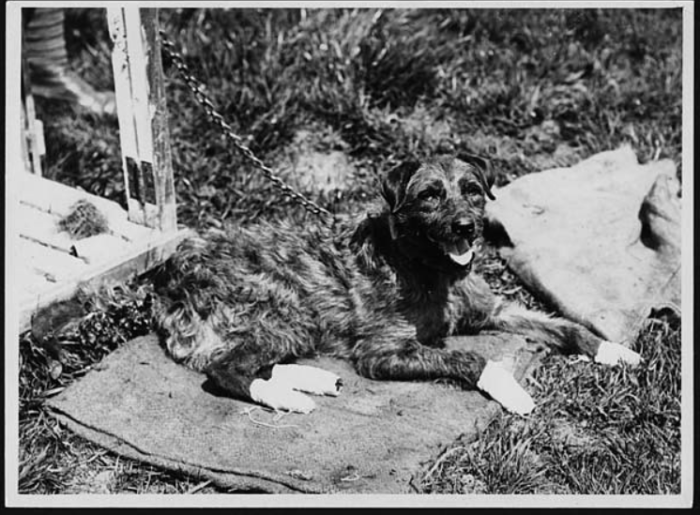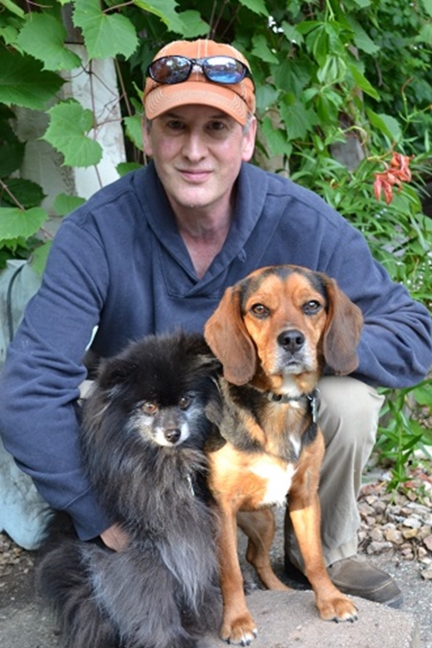by Jeffrey B. Burton
Jeffrey B. Burton, author of The Finders, a fast-paced new mystery novel featuring a heroic golden retriever cadaver dog, discusses the fascinating and tragic history of war dogs utilized in World War I.

In ancient times, the Greeks as well as the Persians, Egyptians, and Romans all utilized war dogs. These canines were trained mostly for sentry duties but every so often they were led into battle. Imagine a critter the size of an English Mastiff—sporting a spiked collar and coat of mail armor—busting through the front line and leaping for your throat. Time to raise the white flag? Sue for peace? Or—of a more urgent nature―turn and run like hell.
However, with the onset of modern weaponry, the use of war dogs evolved into a variety of other roles with other canine responsibilities.
In World War I, the trench soldiers likely thanked whatever remained of their lucky stars for the lethal-weapon-like terriers used to slay the endless rivers of rats they were forced to live with—disease-carrying rats that ate the eyes out of the deceased and made corpses jiggle as they burrowed into soft flesh; rats that gnawed on the wounded who were unable to defend themselves. In fact, terriers were bred as rat killers, and a good terrier could take care of a rat infestation within a matter of hours.Beyond all the praises spoken of terriers for controlling rats in the trenches, when it comes to a favorite role that canines played during the Great War, my vote goes hands down for what was known as the casualty dogs.
Due to their superhuman scenting capacities—some breeds have three hundred million scent receptors whereas us mere mortals have only six million; plus, an eighth of their brain capacity is devoted to deciphering smells—casualty dogs were the origin of our modern day search and rescue dogs. Casualty dogs (also known as mercy dogs or Red Cross dogs, sanitary hounds or sanitatshunde) were originally trained by the German armies of the 1800s to hunt for the wounded and the dying. Sometimes they carried medical supplies in saddlebags, which helped injured soldiers tend to themselves until they could receive medical care from a doctor or battlefield medic.
In wartime, these dogs would test the air—air scenting they call it—for traces of a living human scent. And once these canines latched onto that scent and tracked it to an injured soldier—some poor bastard who’d managed to conceal himself or lay wounded in some obscure spot on the battlefield―they’d return to their handlers, often with leashes in their mouths to indicate that one of their own remained on the battleground in dire need of attention. A rescue party would then trail the dog back to the wounded warrior. The time saved in locating the injured often spelt the difference between life and death, especially in locations far too difficult for a search party of bipeds to pinpoint.
Customarily, casualty dogs could distinguish between the dead and unconscious. If a soldier was dead, the dog would move on; if the soldier was injured, the dog would return to friendly lines for help; and if the soldier was dying, the dog would remain with him to offer comfort. That is, if a wounded warrior was too far gone, the dog would stay with him as he passed away, accompanying him, so he wouldn’t feel left alone. One of the most popular of casualty dog breeds was the boxer as they are ferociously loyal and, in addition to comforting the mortally wounded, boxers would protect these troops to the very end.
If it were not for casualty dogs, thousands of injured soldiers would never have survived the war to end all wars.

This photo is in the public domain via Wikicommons.
One such hero was Rags, a stray terrier from the streets of Paris. American soldiers fed him and Rags, in turn, followed them back to their camp where he was promptly adopted by the US 1st Infantry Division. And Rags stayed with the troops even as they marched into the hell that were the frontline trenches.
Rags had originally been taught to deliver messages but—due to his intense sense of hearing—soon learned to forewarn soldiers of incoming artillery shells by tossing himself onto his side. Rags also developed a knack for finding injured soldiers amongst the battlefield dead. Yup, as a jack of all trades, Rags additionally served as a casualty dog. This scruffy, 24-pound terrier would bring back a piece of uniform to alert medics and soldiers that an American soldier was wounded and in need of rescue.
Rags eventually took too many wounds himself (having been gassed, shelled, and partially blinded) and had to retire from the front lines. He recovered, was taken to America and, after the war, adopted by a military family. Rags lived to be 20, passed away in 1936, and was buried at Aspin Hill Memorial Park in Silver Spring, Maryland with military honors and much fanfare.
The Germans and French and Belgians and Brits―and eventually Americans―utilized war dogs in a variety of roles as well as in substantial numbers throughout the course of World War I. Unfortunately, it came at a tremendous cost. Counting both sides, more than a million of man’s best friends, and battle buddies, were killed.
Sources and additional reading:
Adela Morris and Donna Randolph, Evolution of the Historical Human Remains Detection Dog: Choosing the Best Resource, Institute for Canine Forensics, January 11 – 15, 2006, paper presented at the Society for Historical Archaeology Annual Conference, Sacramento, CA
Blake Stilwell, These were the Mercy Dogs of World War I, August 19, 2019, We Are The Mighty
Boyd R. Jones, On the history of dogs in warfare, Companion Animal Society Newsletter, Massey University, Palmerston North, New Zealand, Volume 26 Number 2
Jennifer Nalewicki, The Animals That Helped Win World War I, May 5, 2017, Smithsonian Magazine
Jon Lucas, 10 Dog Heroes of World War I, September 25, 2018, TopTenz
Melissa, Thompson, The 9 million unsung heroes of WW1: Dogs, horses and carrier pigeons made victory possible, July 31, 2014, Mirror
Rags, the WWI hero dog, featured in B.C. biographer’s new book, November 8, 2015, CBC News, British Columbia
Trench rats killed by a terrier, 1916, RareHistoricalPhotos.com, April 1, 2014Types of War Dogs, The United States War Dogs Association, Inc., viewed March 16, 2020

JEFFREY B. BURTON is the author of The Chessman and The Eulogist. He is an active member of Mystery Writers of America, International Thriller Writers and the Horror Writers Association and lives in St. Paul, Minnesota with his family.
